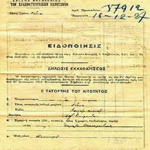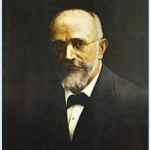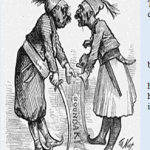An overview of a historical event that changed the
face of modern GREECE
by Haralampos Fotopoulos & Nikos Klapsis (A Class)

“Our world is demolished…Izmir is demolished as well…Horror, a merciless catalyst, grabbed that crowd in his nails and heaved it … You’re not afraid of death, you’re afraid of the terror…It crashes humanity. It starts from the garment and reaches the heart…The terror…Whatever language you speak, you will not find words to describe it …”
Dido Sotiriou “Bloody Earth” P.p. 311-314
September 1922 … The Asia Minor Disaster has happened…
Lifeless silence… Dense black smoke filled the sky of Izmir, above Mount Pago. Minor, flaming pieces of wood swirled in the air and fell on the cosmopolitan quay of Izmir’s old waterfront. And the water, where the waves break on the jetty, took a deep red color….
T he Metropolitan of Izmir, Chrysostom saw the catastrophe approaching and sent a letter to the exiled E. Venizelos:
he Metropolitan of Izmir, Chrysostom saw the catastrophe approaching and sent a letter to the exiled E. Venizelos:
«… Dear friend Eleftherios Venizelos. Hellenism of Minor Asia, the Greek state and the entire Greek nation, is now descending to Hades, from which no more power will be able to rebuild it and save it… «
And shortly before his tragic death, in his last letter, he wrote him, among other things, by begging him to come and unleash them with his rhetorical ability from their diplomatic boundaries…
“But the national hardship was not avoided”…
The successors of Venizelos, who won the elections in 1920 instead of stopping the war, as promised in pre-election terms, led the Greek army into a devastating campaign to the verge of Ankara. Should Greece have attempted such a tremendous invasion by misjudging the conditions presented at that time? However, the new Turkish government no longer recognized the Treaty of Sevres (1920), which made Greece’s dream come into existence. Instead of that, they demanded new peace negotiations with the World War I winners.
“At these critical moments, Greece recalls the man who had been led to abdication two years before”…
Venizelos was recalled from the Greeks to rescue whatever he could. The New Greek regime under the leadership of Nikolaos Plastiras and Stylianos Gonatas, pleads the exiled Venizelos to take on the heavy duty of representing it. Notwithstanding Venizelos returned and faced difficulties which seemed to be unsurpassed. He knew that by the Treaty of Sevres everything had changed. Now the Turkish delegation, headed by Ismet Inonou, adjacent to Mustafa Kemal, was coming to the conference by considering themselves leaders. Venizelos was the visionary of the Great Idea and now he had to negotiate whether this dream could go on or end forever…
 Negotiations for the definitive restoration of peace in the East began on 20 November 1922. Finally, the Peace Treaty (consisting of 5 parts with 143 Articles) and the accompanying Conventions – Agreements – Declarations and Protocols (in total 104 Articles) was signed on 24/7/1923 in Lausanne by the proxies of the governments of the British Empire, France, Italy, Japan, Greece, Romania, the Serbo-Croat-Slovenian State, the US, Turkey, Bulgaria, Russia, Belgium and Portugal. In particular, representatives of Greece were Eleftherios Venizelos and the proxy minister in London Dimitrios Kaklamanos, while Turkey was represented by Ismet Pacha (Minister of Foreign Affairs), Dor Riza Nour Bey (Minister of Health and Social Care – Sinope MP) and Hassan Bey (former Minister – MP of Trebizond).
Negotiations for the definitive restoration of peace in the East began on 20 November 1922. Finally, the Peace Treaty (consisting of 5 parts with 143 Articles) and the accompanying Conventions – Agreements – Declarations and Protocols (in total 104 Articles) was signed on 24/7/1923 in Lausanne by the proxies of the governments of the British Empire, France, Italy, Japan, Greece, Romania, the Serbo-Croat-Slovenian State, the US, Turkey, Bulgaria, Russia, Belgium and Portugal. In particular, representatives of Greece were Eleftherios Venizelos and the proxy minister in London Dimitrios Kaklamanos, while Turkey was represented by Ismet Pacha (Minister of Foreign Affairs), Dor Riza Nour Bey (Minister of Health and Social Care – Sinope MP) and Hassan Bey (former Minister – MP of Trebizond).
Venizelos signed this treaty, by putting aside ambiguities, focusing his policy on actions and especially on the difficulties he had to face…
The Dodecanese were granted in Italy and Turkey, regained a strip of land on the border with Syria and the Bosphorus Strait Internationalized Zone. In Turkey were also granted the islands of Imbros and Tenedos, provided that they would be governed by favorable conditions for the Greeks, as well as Eastern Thrace and Izmir. Greece was obliged to pay in kind the war reparations. The Patriarch of Constantinople lost his leading position, which gave him important status with multiple implications, and the Patriarchate was placed under a special legal status, now controlled by the Turkish government.
Turkey also regained full sovereign rights throughout its territory, with corresponding rights to militarize it – outside the Strait Zone. Turkey resigned from all her sovereign rights in Cyprus (Article 23 of the Treaty) … and from all her claims to areas previously of the Ottoman Empire while being obliged to guarantee the rights of all minorities within her territory. These obligations are of “International Interest”, with a fundamental principle of international law, “pacta sunt servanda”.
This meant that everything that was agreed, had to be respected, and no reconsideration of this Treaty had to be stated. Any sign of disregard was legally mandatory…
The Treaty of Lausanne also included a special, bilateral agreement between Greece and Turkey – signed six months before, on 30 January 1923 – which provided the mandatory exchange of populations between the two countries. This agreement differed from the previous ones. Initially, the mass movement of the populations was established and from then on, it had a mandatory character. Agreements so far have provided voluntary migration of residents to some controversial regions. This exchange was based not on the ethnological composition but on the religious identity of the populations. The excluded areas were West Thrace for Greece and the wider region of Istanbul, the islands of Imbros and Tenedos for Turkey. It is estimated that at least 1,600,000 Greeks were «uprooted» by Turkey, followed by many Armenians, while some 600,000 Turks left Greece.
 Those people according to the exchange contract could:
Those people according to the exchange contract could:
- Acquire the nationality of the country that they would be settled in.
- Have the right to transfer their property.
- Take from the state to which they emigrated as compensation, property of equal value to what they abandoned.
- Have the help of the Joint Exchange Committee for their movement.
It was established in accordance with Article 11 of the Lausanne Convention. It was chaired in Konstantinople and consisted of eleven members (four Greeks, four Turks and three non-neutral members of the First World War). Mainly it determined the mode of immigration and valued the real estate of the exchanges.
Venizelos was a «visionary» and a supporter of refugee settlements in Northern Greece … for «national reasons». He was also a great «politician» and «pacifist,» and the Treaty of Lausanne was the outcome of his political, realism. The Treaty made the possibility of a new war unfeasible and had effectively defended Greek interests in the establishment of the borders with Turkey…. On the contrary to the Treaty of Sevres, the Treaty of Lausanne was humiliating for Greece, since what he won in World War I lost it by Asia. Turkey, on the other hand, lost the prestige of the Empire, but it kept a large part of its territory and its sovereign rights on it.
“Venizelos said that”:
«… The Treaty of Lausanne imposes sacrifice on both States …»
And the People agreed with him…
 This «Honorable Peace» treaty … served the «superior national interest». The people got relieved even though they didn’t welcome Venizelos with excitement.
This «Honorable Peace» treaty … served the «superior national interest». The people got relieved even though they didn’t welcome Venizelos with excitement.
The Treaty of Lausanne was also characterized by many as the «Reciprocity Treaty» because it obliged both countries (Greece – Turkey) to behave in the same way to minorities established in their territory …Generally, it is the only treaty, as it was signed as a consequence of the First World War, which is still in force….
After the Treaty of Lausanne, Greece in 1923, was a defeated and politically divided country, internationally isolated and threatened by the neighboring countries. It was financially shaken and forced to treat more than one million refugees. As for Turkey, after signing the treaty, Mustafa Kemal became President of the Republic of Turkey …
Nowadays, we can count 94 years since the signing of the Treaty of Lausanne…
Greece has always respected the territorial boundaries that have been created by it. Turkey, however, in 1936 with the Mover Convention, allowed the fortification of certain estates (Lemnos-Samothraki) and from 1973 its attitude changed radically. The course of Greek-Turkish relations continues to show a constant controversy, suspicion and hostility…
The Treaty of Lausanne is in dispute…
This challenge opens a new, unknown and multiplied dangerous risk to Turkey’s relations with Greece…
- When does the Lausanne Treaty expire…?
- Has it got an expiring date…?
- Does Greece, have to take everything in mind and be prepared to protect its interests…?
- Is Eleftherios Venizelos dead or not? Is his word, his actions, his mind, his national conscience that make him be a role model for our society? Should we be inspired nowadays by him…? «
A Reply to these questions is going to be revealed by History!!!
However, we have the pleasure to live in a land that it is highly influenced by European values. Either we want it or not, we are still being the offspring of what has happened to the past years regarding the Treaty of Lausanne. A Treaty signed on the shore of a Swiss lake, a treaty which has been until recently considered the keystone of Greek-Turkish relations…..
Let us all be aware …
The terror… This merciless threat…
Whatever language you speak, you will not find words to describe it…
Our epoch got to know wars, hardships, tortures, imprisonment, emigration, and finally contemplates:
“Wars and … wars again…”
“Beast is man ….”






